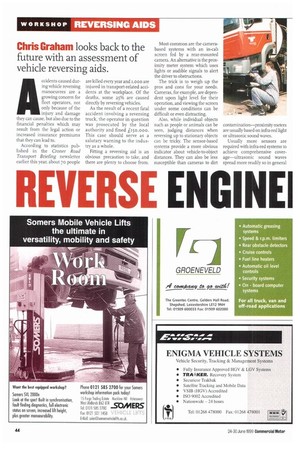Chris Graham looks back to the
Page 46

Page 47

If you've noticed an error in this article please click here to report it so we can fix it.
future with an assessment of vehicle reversing aids.
Accidents caused during vehicle reversing manoeuvres are a growing concern for fleet operators, not only because of the injury and damage they can cause, but also due to the financial penalties which may result from the legal action or increased insurance premiums that they can lead to.
According to statistics published in the Croner Road Transport Briefing newsletter earlier this year, about 70 people
are killed every year and r,000 are injured in transport-related accidents at the workplace. Of the deaths, some 25% are caused directly by reversing vehicles.
As the result of a recent fatal accident involving a reversing truck, the operator in question was prosecuted by the local authority and fined L15o,00o. This case should serve as a salutary warning to the industry as a whole.
Fitting a reversing aid is an obvious precaution to take, and there are plenty to choose from. Most common are the camerabased systems with an in-cab screen fed by a rear-mounted camera. An alternative is the proximity meter system which uses lights or audible signals to alert the driver to obstructions.
The trick is to weigh up the pros and cons for your needs. Cameras, for example, are dependent upon light level for their operation, and viewing the screen under some conditions can be difficult or even distracting.
Also, while individual objects such as people or animals can be seen, judging distances when reversing up to stationary objects can be tricky. The sensor-based systems provide a more obvious indicator about vehicle-to-object distances. They can also be less susceptible than cameras to dirt
contamination—proximity meters are usually based on infra-red light or ultrasonic sound waves.
Usually more sensors are required with infra-red systems to achieve comprehensive coverage—ultrasonic sound waves spread more readily so in general fewer sources will be required.
Benfell's Reverse Guard is an ultrasonic-based system which uses technology taken from the submarine industry. Managing director Michael Leigh says: "The sound waves produced are spread up to rzo° in the horizontal plane and 90° vertically, meaning one sensor at each end of the rear bumper and a third in the centre, will provide full coverage."
Installation time very much depends upon the type of vehicle. Any system which requires wiring to be fed into the cab increases fitting time and complexity. It can also become a warranty issue if additional holes have to be drilled.
Leigh explains: "The need to link a system to the cab can be avoided by fitting lights to the trailer. These are activated by the sensors at the back and viewed through the driver's mirrors. The lights can be located on the outer sides of an articulated trailer or rigid body, or fixed to the front bulkhead."
Benfell's suggests that fitting its system to a rigid vehicle takes about two hours, or 30 minutes less for installation on a trailer where no cab fitting is required.
One advantage of the traileronly option is that it will continue to work irrespective of which tractor is towing it, as long as the trailer has a reversing power feed to trigger the system.
An advanced variation on the theme from Ben fell's is Forward Guard. It's believed to be the only product of its sort on the market and is designed to warn of obstacles lurking in the nearside blind spot immediately ahead of the cab. The system requires no input from the driver; it is activated automatically below a predetermined speed via a direct link with the tacho.
The driver is alerted by an audible signal and has the opportunity to mute the alarm if caught in traffic. When silenced, warnings continue to be signalled by a flashing light. Once vehicle speed builds up again, muting is cancelled and the system reverts to normal "with sound" operation, so no manual re-setting is required. However, reversing aids are not only sold for their safety implications. Many operators believe that the reduction in downtime, created by this type of equipment is an equally significant benefit.
Bill Richardson of Wincanton Logistics says: "We've carried out extensive testing of Benfell's Reverse Guard and found that it reduces accident damage significantly. Additionally, it boosts driver confidence which is also very beneficial."
Reducing the risk of careless reversing accidents can certainly result in a very real saving as far as repair costs are concerned.
Dealing with unscheduled scrapes and shunts is time-consuming and expensive. It makes sense to do all you can to minimise these risks, and reversing aids certainly have a role to play.
USEFUL CONTACTS
• Benfell's: 01253 295500 • Groeneveld: 01509 600033
• Proximeter Co: 0171 345 5050 II Vision Techniques: 01254 679717




















































































































